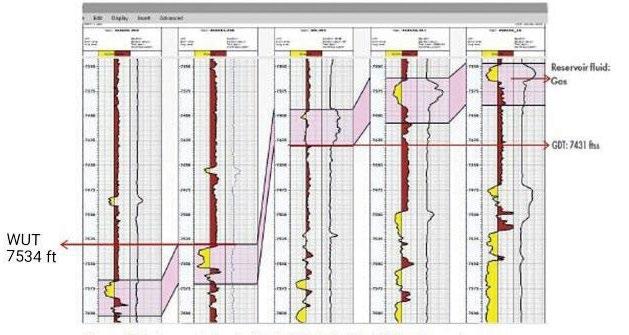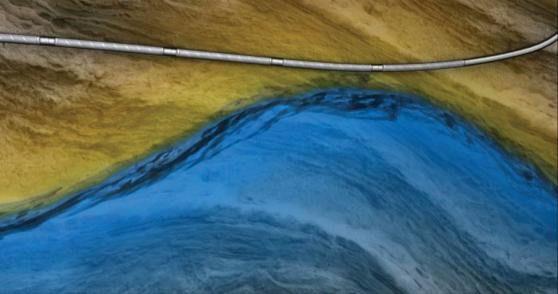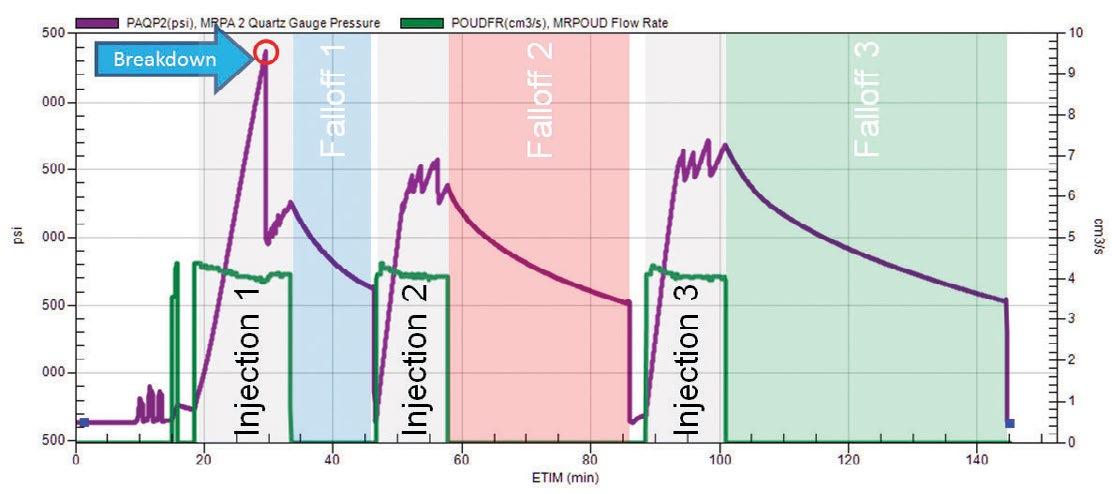YOUNG RESEARCHERS
A Fast-Tracked Development Plan of Alpha Reservoir (A Partially Appraised Field) Through Integrated Studies Lawrence Ahiwe - Geosciences and Petroleum Engineering, University of Benin Determination of the viability of a reservoir for development often requires building confidence around key decision parameters. The objective of this project is to eliminate extra costs associated with full reservoir appraisal by establishing confidence on identified uncertainties, managing, and building models to capture them. MAR A field is a green field with limited well penetrations. The objective reservoir is a relatively shallow one, with 5 well penetrations. Two of the wells are wet, while the rest penetrated hydrocarbon bearing intervals. Neutron-density logs acquired in one of the wells (MAR 15) that penetrated the hydrocarbon interval show the presence of gas. In addition, assessment of sidewall samples and ditch cuttings further validates the presence of gas in the reservoir. However, no contact has been logged from any of the wells. This, and other subsurface uncertainties, were managed with new technologies in order to achieve the aim of the project. 3D static modeling captured static uncertainties (i.e. structure, stratigraphy and rock properties) of the reservoir, following identification of limitations to reservoir development. The impact of dynamic properties on fluid recovery determined the outcome of the production forecast of the selected development concept. Impacting uncertainties in reservoir development have been managed and reduced sufficiently for development. Fluid contact uncertainty has been reduced to 20ft (from 103ft), thus eliminating presence of a producible oil rim, and managing structural uncertainty. For optimal recovery, the selected development concept targets a single well (with a pilot appraisal hole), and tubing size of 4.5�, at a rate of 50MMScf. Preliminary economic evaluations estimate a capex of $68.6m on the proposed development well, against $93.6m in a full appraisal to development scenario. The development project is viable even in the low case outcome. This study eliminates additional costs (about $25m) that would have been incurred by appraisal and fast-tracks reservoir development. Oil and gas industry is well established as a high-cost, high-risk venture, where successes when achieved, are fulfilling. Usually, companies employ cost-cutting strategies (that do not undermine operational safety) to maintain a reasonable bottom-line and margin, especially since the current uncertainty and bust in crude prices and revenue from petroleum products. The main thrust of this work is on cost reduction techniques, focused on the pre-production phase of reservoir development.
tions were used. 4. Pressure data
Background of Study
The reservoir under study is the Alpha reservoir, one of 16 reservoirs in a partially appraised field (MAR A field) in the Central Swamp depobelt of the Niger Delta basin, Nigeria. The MAR A field was discovered in 1971, and, up to the time of this work, was a green field. 3D seismic data has revealed the field as a fault-bounded simple roll-over structure, with a relatively low relief. It also has minor intra-field listric faults, particularly a large fault which segments the field at some levels. The focus is to fast-track the field development using current technology to delineate possible fluid contact(s) against dedicated appraisal well(s), to establish the presence or absence of an oil-rim. This in effect, will reduce costs associated with drilling more appraisal wells and building additional facilities (except flow-lines, pipelines and manifolds). As a partially appraised field, a set of uncertainties were identified for management. These include: 1. Structural uncertainty due to sparse well control. 2. Uncertainty in fluid types and depth of fluid contact.
Data Availability
The MAR A field faces the challenge of sparse information and large data gaps. The field data review is enumerated below: 1. Seismic data 2. Core samples/Biostratigraphic information 3. PVT data: No fluid samples were obtained from the wells, and hence no experimental PVT data. As a result, existing correla-
18 | E C H O
•
F E B R U A R Y 2016
Fig. 1 - A Log Panel Showing the GDT and WUT of Alpha Reservoir
Methodology
The methodology employed to fast-track reservoir development from field appraisal was that of an integrated, multi-disciplinary approach. Pressure gradient analysis is the method adopted in this study for the investigation of a possible oil rim within the objective reservoir. The theory is based on the variation in fluid gradient especially around the GOC. In testing the possibility of an oil rim in the objective reservoir column, where a gas column has been established, different possible oil gradients were plotted below the gas gradient line, against an established hydrostatic line. Different depth realizations were tested below the established Gas-Down-To (GDT) in order to evaluate the possibility of a GOC/OWC. The idea was that, should an oil rim exist within the interval of investigation, the different pressure gradients of oil and gas will establish a pressure gradient profile. For example, the oil gradient line will intersect the hydrostatic line above the Water-Up-To (WUT) line. The model was also calibrated with data from reservoirs with established GOCs.
Results and Discussion
From the oil-rim investigation done, analysis showed that at depths below the GDT up to 20ft above the WUT line, there was








